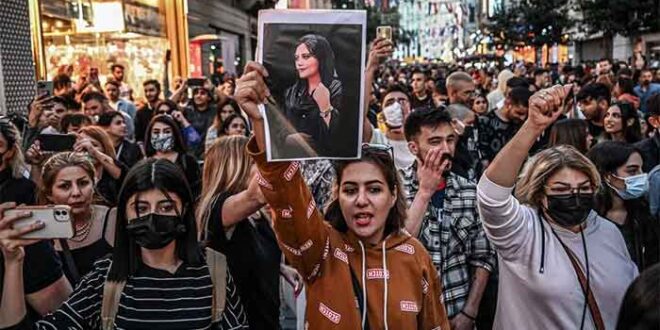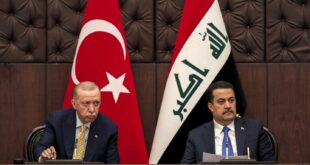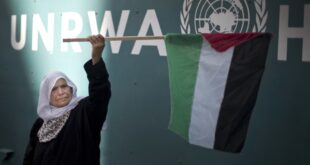Since the death of Mahsa Amini on September 16, unrest in Iranian cities has continued. So far, more than 100 people have been killed in the riots, and many political activists, journalists, and college students have been arrested. On October 3, after over two weeks of silence, the Supreme Leader, Ali Khamenei, appeared at a police graduation ceremony and blamed the unrest on the United States, Israel, and the Iranians abroad who helped them. He claimed that if Amini had not died, the United States and Israel would have found other excuses to create unrest in Iran. Surprisingly, Khamenei did not blame London, which is the center of Persian Language broadcasts that instigated the recent unrest. Historically, the British have had friendly relations with mullahs, believing religious ideas maintain social control and promote their interest in Iran. Ahmad Vahidi, the Minister of Interior, said he has some evidence that the protesters were paid by foreign agencies and some have been trained to make Molotov cocktails for the rioters. Subsequently, Khamenei, in another speech on October 14, said no one should dare to think that the Islamic Republic can be uprooted.
While Khamenei blamed the foreigners and the Iranians abroad, he did not refer to the opposition political factions at home who have demanded ending the theocratic dictatorship. Inside Iran, there has been a class war going on between the conservative Islamists and other political factions. The conservative clerics have been close to the lower class. Since the revolution, they have controlled the lower class by preaching superstitious ideas and giving them financial aid through Islamic endowments and employment in government jobs to get their political support. The opposition factions include those who want to see the demise of the theocratic regime and the “reformists, “who are led by a few moderate clerics. The reformists believe the Islamic regime can be reformed. They have the support of the affluent class and advocate neoliberal economic policies. The reformists’ faction headed the executive branch of the government under three cleric presidents: Akbar Hashemi Rafsanjani (1989-1997), Mohammad Khatami (1997-2005), and Hassan Rouhani (20013-2021). However, they were not successful in implementing policies that could help the country. As a result, the potential for regime change in Iran is high, and the recent uprisings by the youth have provided a ground for it.
Iran and Oil Politics
The destiny of the Iranian people has been tied to international oil politics. It was the case before the 1979 revolution, and it is now. Iran has been a victim of oil politics. The formation of the Islamic Republic and the rise of clerics to power in Iran was the collateral damage of the cold war and the higher oil prices in the 1970s incurred on the people of Iran. At the time, the US economy had experienced a high rate of inflation, as it is currently. The US wanted to lower oil prices to reduce inflation and help its economy to recover from recessions. While the Shah had banned all opposition political parties, the only groups that could be organized to become politically active were the Islamists led by the mullahs. The Western powers pressured the Shah to support lowering the oil prices, but he was reluctant to do so. As a result, they decided to support the Islamists to topple his government and take power.
A second cold war is in progress between China and the US, and Iran’s oil is at stake. An era of higher oil prices has arrived again, and both the US and European economies are in recession and need cheaper oil to feed their economies. The Biden administration’s “Plan A” option was to re-enforce the 2015 nuclear deal (JCPOA) to eliminate Iran’s nuclear deterrent and lift the sanctions on Iranian oil export so that the world oil supply would increase and lead to lower oil prices. The recent nuclear negotiations, which began in December 2021, reached an impasse in August 2022, and its future is bleak. Based on Iran’s advances in nuclear technology, the prospect of a new deal is not promising. Suddenly, on October 5, 2022, the OPEC+ members decided to cut their total oil production by two million barrels per day. That has caused oil prices to rise and has contributed to higher inflation rates in Europe and the United States. The Saudis no longer want to play the role of oil price adjustor as they have done before. Moreover, on September 16, 2022, Iran was embraced as a full member of the Shanghai Cooperation Organization (SCO).[1] Iran’s acceptance to join SCO has provoked the Western powers to choose “Plan B” which is a media campaign to destabilize Iran and may pave the way for a regime change. Coincidently, Plan B was activated after the death of Mahsa Amini on September 16! This plan has been launched in cyberspace through the Persian language media outlets centered in London. Plan B has aimed at the Achilles’ heel of the clerical regime, the younger generation who oppose the clerical rules.
The Younger Generation’s Uprising
The uprising that started from protests over women’s hejab has continued. Many students in schools and universities have joined the protesters. Also, there have been scattered worker strikes in a few oil and petrochemical facilities. This movement is quite different from the previous uprisings against the theocratic regime. A new younger generation in this uprising demands social change. Clerics need to wake up from their nightmares and respect people’s fundamental rights.
The ruling clerics have been faced with a new generation of young Iranians who have been raised and educated under their reign. This generation, mostly in their teens and twenties, has challenged clerical repression. The regime has been caught off guard by encountering awakened students in schools and universities in the digital age. Despite incorporating religious ideas in the educational curricula and in the state-sponsored media outlets, the youth discard clerical preaching. They have realized the mullahs’ ideological preaching cannot help them to get ahead. The younger generation does not want to say some words and phrases in Arabic, like a parrot repetition, without knowing what they mean and how it can help them to live better. They do not understand how superstitious ideas such as the pilgrimage to imams’ shrines can improve their lives.
In the past few years, as the number of women in universities has reached parity with men, there has been a gender revolution going on in Iran. The traditional patriarchy in Islamic culture has been challenged by educated women. The emergence of the information age has brought them smartphones, social networking, etc., which has challenged the clerics’ superstitious ideas. Emancipated women want to live their lives and ignore the clerics’ superstitious preaching ideas.
Media Censorship has Failed
The clerical regime has monopoly power over the radio and television in Iran and has strictly censored the press and filtered the internet. All books have to obtain permission from the government before being printed. The ministry in charge of the permits often gives conditional approval pending deleting some pages and or modifying the manuscript the way that fits the clerics’ ideology. Since the revolution, more than 50 periodicals, including some newspapers with vast circulation, have been banned, and their editors have often been penalized or imprisoned. While the government has banned many books and newspapers, it subsidizes printing and promotes many religious and superstitious books written by the mullahs and their followers. Any book or article that questions such ideas is banned.
Some books that had been printed before the revolution and had criticized the clergy or questioned legends regarding the Shi’s imams are strictly banned. A number of books written by some well-known writers, such as Sadegh Hedayat, Ahmad Kasravi, and Ali Dashti are banned because of their anticlerical contents. To the displeasure of the clergy, today, new technology has made those books available on the internet and can be downloaded for free.
The Protesters Want Quick Change
Protesters want fundamental changes. If significant changes are not rapidly made, the country will be further weakened, and there could be a period of anarchy. The clerics have to choose between a quick metamorphosis or chaos in the country. They have to respect the people’s fundamental rights, end theocratic dictatorship, lift the ban on political parties, free political prisoners, allow the labor unions to demand their legitimate requests, and allow freedom of the press. If not, the foreign powers may take advantage of the situation and pursue their own imperialistic goal to destroy Iran’s defense system and impede its progress.
 Eurasia Press & News
Eurasia Press & News




